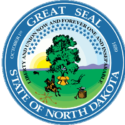North Dakota became a state in 1892, joining the Union as a strong Republican state.
It hadn’t always been that way, though. Republicans and Democrats came in and out of power, assisted in some cases by independents. They weren’t just playing political games, though; they had some serious issues.
For one thing, the territory was offering huge incentives to businesses, trying to bring industry and money into the territory. One side disapproved of the plan, pointing out that the railroad companies and other corporations that moved in and took those incentives were paying very little to the territory. They stayed at a distance, ignored the interests of the territory, and didn’t create many jobs.
The opposition pointed out that businesses were nervous about investing in a territory… especially in a territory with so much political upheaval. Without the stability of statehood, North Dakota didn’t have much to offer. The territory was famous for corruption and still sparsely populated, so it didn’t look like an ideal business partner. Statehood supporters wanted the stability and prosperity that statehood would bring.
In fact, the railroads liked working with the Dakota Territory. They knew that their power would diminish when the Dakotas became states. They worked against statehood for both North and South Dakota.
Meanwhile, Congress considered statehood for the Dakota Territory repeatedly, but they weren’t sure whether they should make it one state or two, or whether they should admit part and leave the other part as a territory. In the territory and outside of it, there were also some public relations issues. North Dakota was known for conflicts between Native Americans and settlers, and considered a wild place full of fur traders, unlike the more settled agricultural south half of the territory.
After years of working toward statehood, though, North Dakota was finally included in a February 1892 bill that admitted North Dakota, South Dakota, Montana, and Washington, as long as they were able to pass constitutions. North Dakota held its constitutional convention and passed a constitution later that year.
Did North Dakota really become a state in 1892?
Statehood didn’t immediately end the political divisions or the difference of opinion over incentives. Many observers believed that North Dakota’s government did the bidding of the railroads and corporations, not of the people. Many of the territory’s problems lingered on for years, and there was a “railway war” in 1905.
North Dakota’s transition to statehood was so messy that the state had to amend its constitution in 2012 to clear up a technicality. The state constitution was in conflict with the U.S. Constitution — and some wondered whether that might invalidate statehood for North Dakota.
Constitutional scholar Cheryl Hanna said that wasn’t an issue. “Congress can approve a state under any rules that it sets,” she pointed out, “and that is a separate and distinct question from whether each state has taken the right constitutional steps.”
Puerto Rico’s path to statehood has been filled with questions about technicalities, from the percentage of people voting for statehood to concerns about its official language. Hanna’s remarks about North Dakota make it clear that Congress can grant statehood by choice, without concern about those minor issues.
Territorial law expert Howard Hills offers another takeaway for Puerto Rico. “Every minute spent talking about internal politics under the territorial regime is a minute wasted,” he wrote in Citizens Without A State. Territories should focus on achieving statehood. It will be easier to sort things out after being admitted — and unity is an important step toward that outcome.








No responses yet